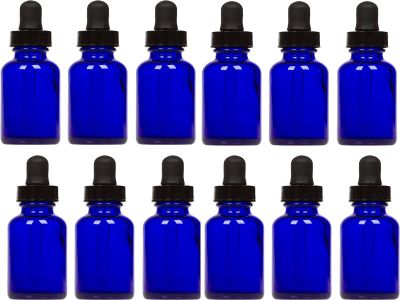callmerob
starting to spend too much on rocks
  I really like a dirt road
I really like a dirt road
Member since September 2019
Posts: 143
|
Post by callmerob on Oct 17, 2022 19:44:40 GMT -5
My sculptor friend gave me a rock from the swap meet and said that it looks like one of those geode things. Covered in mudball, about 3” long, shaped like a potato, but what caught my eye is a trace of blue. rough rock ![]()  blue trace  The hole saws knock off the loose semi-petrified mud and gravel pretty well. Lots of mud. machine  hole saws  blue trace  Definitely blue. I’ve seen ordinary dirty quartz, but not blue, so why is it dark blue? Must be chemistry/minerals. A dark rich blue pigment is cobalt blue, used in art paint, but beyond that I have no clue. Anyone got an idea? Oh, and did I mention the basalt under the mudball? Fast becoming my least favorite material. After grinding through a 1/4” layer of mud and gravel there’s blue agate(?) and basalt. agate & basalt 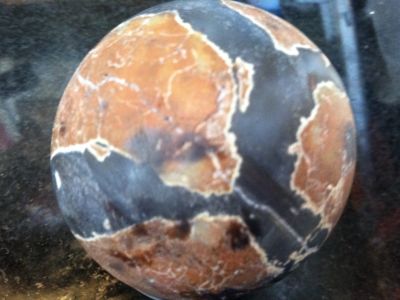 agate & basalt 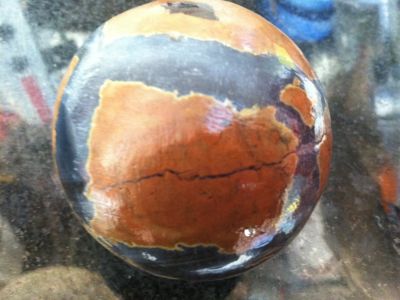 The hole saws make a lot less mud now, barely a trace in a water drip, and grind only in line contact with the ball. Maybe I’m too impatient. But I want more diamonds. So I bought more diamonds. Twenty-five dollars gets ten grams of fifty grit. It”s a little teeny bag, maybe a few level teaspoons. But I don’t need much. My SiC grit / super glue bottle cap cups are worn dull, so add a pile of diamonds, smush the ball to make a dent, add super glue. cups 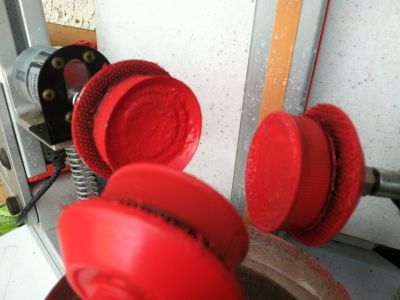 cups & ball 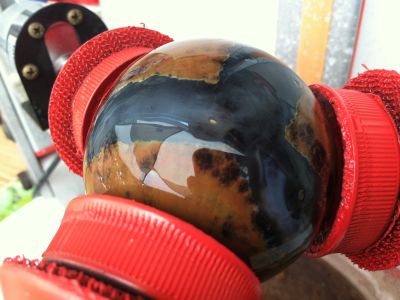 Paint is a wear indicator, and there’s not a lot of wear. Not many diamonds in the cut. And I used the ball to make a conformal dent. And I’m a careful smusher, I swear. This shoulda worked better than it did. cup  Thought I’d try the DIY diamond segments for hole saws. These also only contact the ball in a thin line around the inner edge. Only a few diamonds showing. Added a sprinkle of 50-grit loose SiC to the wet ball, and let it chew on the ball and the tools for a while. A chamfered tool edge makes a place to smear super glue and sprinkle diamonds. Builds up quite nicely. These tools ground the ball smaller and rounder with a little help from the Lortone diamond wheel on high spots. Finally realized that the agate cavity is probably not spherical, basalt isn’t going away anytime soon, and a pure agate sphere will be a small marble, so stopped rough grinding at 2” diameter. diamond segments  add diamonds 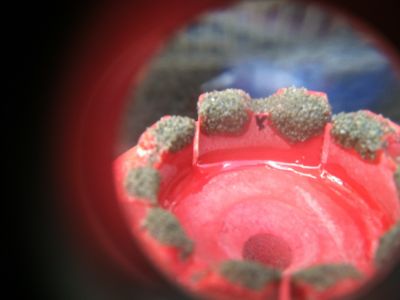 add paint  Made a bunch of these next tools for softer plastic diamond pads in grits 50, 200, 400, 800. Each grit runs for most of the day, so it’s not fast, but it gets there. Pre polish is a watery paste of 1000-grit SiC on felt buffing pads. Polish is 10000(?)-grit aluminum oxide on rayon buffing pads. machine  pads  pads 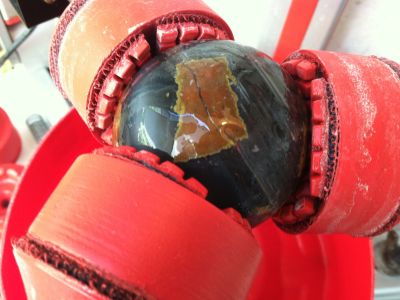 Paint is a wear indicator. Not much contact area, but eventually it wears more and works better. pad wear  Basalt doesn’t polish so well, but the sphere is round and shiny. Planet Blue Agate is it’s own little world.  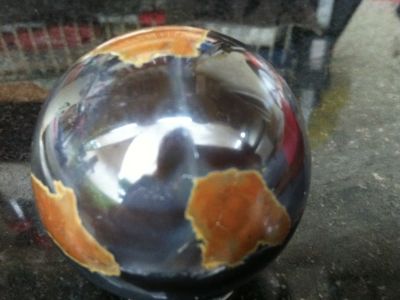   Hope you like it.  |
|
|
|
Post by Pat on Oct 17, 2022 19:52:40 GMT -5
I DO like it! And everything is so clean!! Thanks!
|
|
hypodactylus
spending too much on rocks
 
Member since July 2021
Posts: 478
|
Post by hypodactylus on Oct 17, 2022 20:25:05 GMT -5
This is great! Looks like a little planet, like you said!
|
|
Deleted
Deleted Member
Member since January 1970
Posts: 0
|
Post by Deleted on Oct 17, 2022 20:39:17 GMT -5
Thats awesome! You got that basalt pretty shinny for basalt!  |
|
|
|
Post by jasoninsd on Oct 17, 2022 20:51:01 GMT -5
First...thank for explaining your process and DIY aspect! Second...HOLY CRAP that sphere is amazingly beautiful!! You're right about an "otherworldly" little planet!  |
|
|
|
Post by hummingbirdstones on Oct 17, 2022 21:23:12 GMT -5
First...thank for explaining your process and DIY aspect! Second...HOLY CRAP that sphere is amazingly beautiful!! You're right about an "otherworldly" little planet!  what Jason said!  |
|
|
|
Post by Pat on Oct 17, 2022 21:42:57 GMT -5
The blue with brown reminds me of Richardson Ranch Thundereggs in Oregon. You would probably have to slab it to be certain……
|
|
|
|
Post by pebblesky on Oct 17, 2022 22:57:16 GMT -5
Thanks for sharing with us the wonderful journey!
|
|
|
|
Post by amygdule on Oct 17, 2022 23:49:56 GMT -5
Thunder Eggs into Spheres
Is an Interesting Process
Thank you for sharing
|
|
vance71975
freely admits to licking rocks
  
Member since September 2022
Posts: 760
|
Post by vance71975 on Oct 18, 2022 3:06:25 GMT -5
That is Amazing!
|
|
|
|
Post by rockjunquie on Oct 18, 2022 6:41:35 GMT -5
Thanks for a great post! The sphere is gorgeous! I can only imagine your excitement when you started seeing the beauty under that rough exterior.  |
|
|
|
Post by liveoak on Oct 19, 2022 6:51:49 GMT -5
First...thank for explaining your process and DIY aspect! Second...HOLY CRAP that sphere is amazingly beautiful!! You're right about an "otherworldly" little planet!  Way Cool
Patty
|
|
Tommy
Administrator 
Member since January 2013
Posts: 12,981
|
Post by Tommy on Oct 19, 2022 12:45:47 GMT -5
callmerob thats gorgeous! Thanks for sharing your process with us too. I've always wondered why I don't see more thundereggs made into spheres. It seems like a natural shape beginning point. Maybe they are doing it and I'm just not paying attention 
|
|
electrocutus
spending too much on rocks
 
Member since October 2020
Posts: 341 
|
Post by electrocutus on Oct 19, 2022 15:36:32 GMT -5
It looks absolutely amazing. I love rock spheres!
|
|
callmerob
starting to spend too much on rocks
  I really like a dirt road
I really like a dirt road
Member since September 2019
Posts: 143
|
Post by callmerob on Oct 19, 2022 15:53:32 GMT -5
The blue with brown reminds me of Richardson Ranch Thundereggs in Oregon. You would probably have to slab it to be certain…… Thank you Pat for a great clue as to the possible origin of this rock. Ive heard of Richardson Ranch, and I wonder if the blue color is possible in thundereggs from their property. Looking at their website shows thundereggs with the same dark blue color. 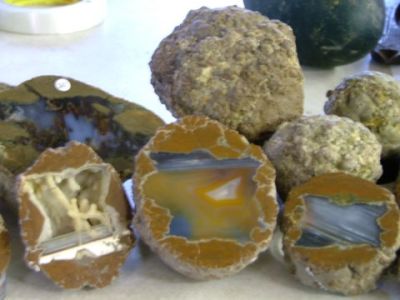 richardsonrockranch.com/photos/ richardsonrockranch.com/photos/In north central Oregon maybe it is a part of of the flow basalts that form the Columbia Plateau. Also learned about Ellensberg Blue, though the source has mostly eroded away. It is very rare, light blue to lavender, and found as small fragments. Central Washington University found a unique spike in zirconium. A CWU geologist gives a 50-minute public lecture on Ellensburg Blue and the eroded source formations. He sounds like a guy you'd want to have a beer with. Thanks for such great info, and thanks to all who comment.  |
|
|
|
Post by Son Of Beach on Oct 19, 2022 16:37:53 GMT -5
Professor Nick is the man
|
|
|
|
Post by rockpickerforever on Oct 19, 2022 16:50:08 GMT -5
Professor Nick is the man Yes! I love his YT videos. He has a bunch of them. Can't watch them without learning something! |
|
|
|
Post by DirtCleaner on Oct 24, 2022 8:37:12 GMT -5
Strong work. Love to see theingenuity in creating tools.
|
|
callmerob
starting to spend too much on rocks
  I really like a dirt road
I really like a dirt road
Member since September 2019
Posts: 143
|
Post by callmerob on Oct 24, 2022 12:28:49 GMT -5
|
|
callmerob
starting to spend too much on rocks
  I really like a dirt road
I really like a dirt road
Member since September 2019
Posts: 143
|
Post by callmerob on Oct 24, 2022 13:13:22 GMT -5
Wikipedia says it's all just Inorganic Chemistry. "Cobalt glass—known as "smalt" when ground as a pigment—is a deep blue coloured glass prepared by including a cobalt compound, typically cobalt oxide or cobalt carbonate, in a glass melt. Cobalt is a very intense colouring agent and very little is required to show a noticeable amount of colour. Cobalt glass plates are used as an optical filter in flame tests to filter out the undesired strong yellow light emitted by traces of sodium, and expand the ability to see violet and blue hues,[1] similar to didymium glass. Moderately ground cobalt glass (potassium cobalt silicate)—called "smalt"—has been historically important as a pigment in glassmaking, painting, pottery, for surface decoration of other types of glass and ceramics, and other media.[2][3] The long history of its manufacture and use has been described comprehensively.[4] Cobalt aluminate, also known as "cobalt blue",[5] can be used in a similar way. Cobalt glass such as Bristol blue glass is appreciated for its attractive colour and is popular with collectors. It is used in the distinctive blue bottles of Harvey's Bristol Cream sherry and Tŷ Nant mineral water. The earliest known example of cobalt aluminate glass dates to a lump from about 2000 BC in ancient Mesopotamia, very possibly intended for use as a pigment; it was rare until the modern era. Cobalt oxide smalt appears as a pigment in Egyptian pottery about five centuries later, and soon after in the Aegean region. In paintings, smalt has a tendency to lose its color over a long period, and is little used today.[2] However, when used in ceramics for underglaze decoration, it keeps its colour well, and is the main blue used in blue and white pottery from a wide range of dates and areas, including Chinese blue and white porcelain from the Yuan and Ming dynasties, Renaissance Italian maiolica and Delftware.[6] Chinese porcelain used smalt glazes from the Tang dynasty onwards, though Chinese cobalt glass is found from the Zhou dynasty (1122–221 BC).[6] Cobalt was used as a pigment in Central Asia from the 13th century. A fragment of a mud painting in the ancient Tangut city of Khara-Khoto has been found to contain smalt, judged to be dated between the 11th and 13th centuries.[7] A large quantity of smalt was purchased for the decoration of the gallery of Francis I of France at Fontainebleau in 1536.[8] Smalt, normally now discoloured, is common in European paintings from the 15th to 17th centuries. For example, it is found in Hans Holbein the Younger's portrait of Sir William Butts (ca. 1540), in Michael Pacher's painting "The Early Fathers' Altar" (ca. 1483), and in the frescos of Domenico Ghirlandaio (1449–1494).[9][10] The invention of a European smalt process has traditionally been credited to a Bohemian glassmaker named Christoph Schürer, around 1540–1560.[11] However, its presence in Dieric Bouts' The Entombment from circa 1455 proves that it was used at least a century earlier.[12] In England and Scotland, smalt was added to laundry starch. James VI and I considered awarding a patent for making a "blue azure" product for this purpose in Scotland in February 1609.[13] The process used for producing cobalt smalt glass at the Blaafarveværket industrial manufacturing center in Norway in the 19th century has been documented as smelting cobalt oxide together with quartz and potassium carbonate. The result was an intensely blue glass-like substance that was ground and sold to producers of glassware and porcelain.[14]" Thanks to Wikipedia for doing my homework for me. So glass makers can add cobalt oxide, quartz, and potassium carbonate to get dark blue. I guess Mother Nature can do that too. Oh, and This Crowd is probably relieved at no homework too.  |
|




































